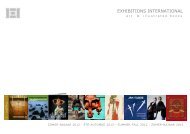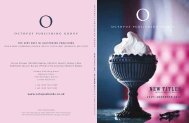DYNAMIC IDENTITIES How to create a living brand
DYNAMIC IDENTITIES How to create a living brand
DYNAMIC IDENTITIES How to create a living brand
You also want an ePaper? Increase the reach of your titles
YUMPU automatically turns print PDFs into web optimized ePapers that Google loves.
Fifty years ago, a <strong>brand</strong><br />
was just a single mark<br />
used for <strong>brand</strong> recognition,<br />
which set it apart from<br />
the rest. Now a <strong>brand</strong> has<br />
become a platform where<br />
like-minded people come<br />
<strong>to</strong>gether, and an experience<br />
that <strong>create</strong>s emotional<br />
attachment. Brands need<br />
<strong>to</strong> constantly adapt <strong>to</strong> their<br />
fast-changing environment<br />
in order <strong>to</strong> survive. Internet,<br />
social media and technical<br />
revolutions have given<br />
<strong>brand</strong>s the opportunity <strong>to</strong><br />
behave like <strong>living</strong> organisms.<br />
DESIgNINg<br />
<strong>IDENTITIES</strong> for<br />
lIvINg orgANISMS<br />
MTV, Container<br />
Logo design by Manhattan Design, 1981<br />
A logo, a set of colours and a font, that’s all<br />
it takes <strong>to</strong> <strong>create</strong> a visual identity. At least,<br />
that’s how designers have set <strong>to</strong> work<br />
for a long time. There has been a shift in<br />
recent years <strong>to</strong>wards creating more organic<br />
identities, using more and variable elements.<br />
New technologies have made this possible,<br />
combined with a shift from print <strong>to</strong> screen.<br />
Although we still exchange business cards,<br />
most interaction <strong>to</strong>day takes place online.<br />
This gives <strong>brand</strong>s the opportunity <strong>to</strong> <strong>create</strong><br />
a much more vivid and variable identity, using<br />
a different logo each day if they wish. Internet,<br />
social media and technical revolutions have<br />
given <strong>brand</strong>s the opportunity <strong>to</strong> behave like<br />
<strong>living</strong> organisms. It has also <strong>create</strong>d the<br />
possibility for companies <strong>to</strong> come closer <strong>to</strong><br />
their clients and vice versa. These new forms<br />
of interaction feed a company and should be<br />
expressed within its identity.<br />
An identity should reflect the values and aims<br />
of a company as a whole. What drives it, what it<br />
believes in, why it exists. This is not something<br />
static, frozen in time. It is always evolving,<br />
growing, adapting <strong>to</strong> new circumstances.<br />
A person has a vision, a wardrobe and a<br />
circle of friends evolving and changing as<br />
they grow up, meet other people, travel,<br />
live. In the same way, a company is also<br />
an organic entity: influenced by, adapting <strong>to</strong>,<br />
and changing through economic and social<br />
circumstances, the vision of a new CEO,<br />
or a major technological breakthrough.<br />
Learning companies are dynamic and should<br />
therefore have a dynamic identity that is<br />
flexible enough <strong>to</strong> meet all these changes, <strong>to</strong><br />
incorporate and reflect them. An identity should<br />
be as organic as the company it is designed for;<br />
it should speak its language, grow with it,<br />
and adapt <strong>to</strong> its environment.<br />
Dynamic components<br />
The way I see it, there are six components <strong>to</strong><br />
an identity. A logo is one of them, colour and<br />
typography makes three, and then there are<br />
graphic elements, imagery and language.<br />
Together they form a system that builds the<br />
identity of the <strong>brand</strong>.


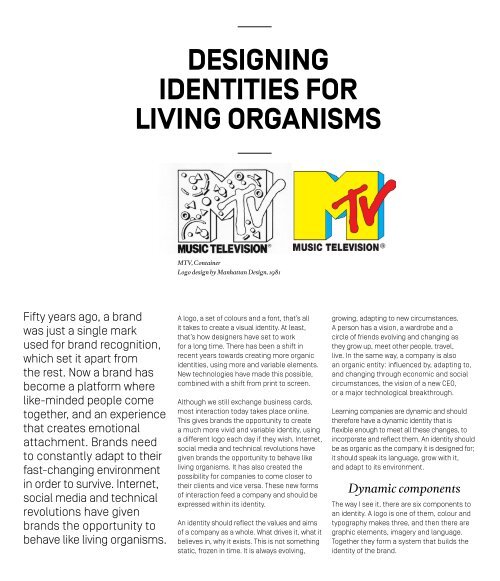

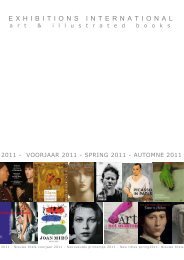


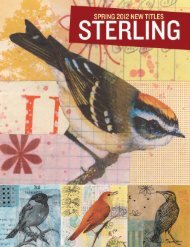


![01 -[BE/INT-2] 2 KOL +UITGEV+ - exhibitions international](https://img.yumpu.com/19621858/1/184x260/01-be-int-2-2-kol-uitgev-exhibitions-international.jpg?quality=85)



